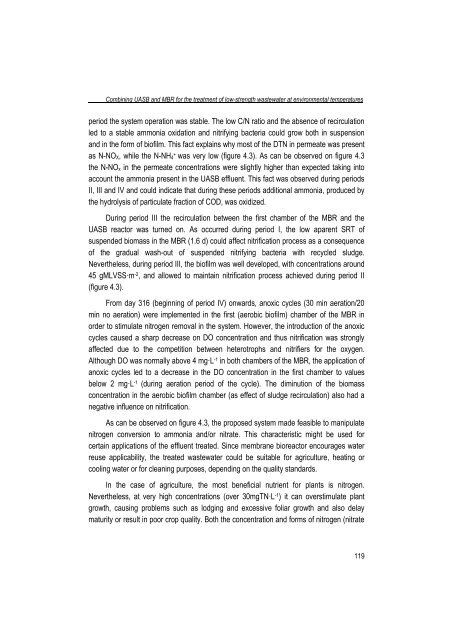Combining submerged membrane technology with anaerobic and ...
Combining submerged membrane technology with anaerobic and ...
Combining submerged membrane technology with anaerobic and ...
Create successful ePaper yourself
Turn your PDF publications into a flip-book with our unique Google optimized e-Paper software.
<strong>Combining</strong> UASB <strong>and</strong> MBR for the treatment of low-strength wastewater at environmental temperaturesperiod the system operation was stable. The low C/N ratio <strong>and</strong> the absence of recirculationled to a stable ammonia oxidation <strong>and</strong> nitrifying bacteria could grow both in suspension<strong>and</strong> in the form of biofilm. This fact explains why most of the DTN in permeate was presentas N-NO X, while the N-NH 4+was very low (figure 4.3). As can be observed on figure 4.3the N-NO x in the permeate concentrations were slightly higher than expected taking intoaccount the ammonia present in the UASB effluent. This fact was observed during periodsII, III <strong>and</strong> IV <strong>and</strong> could indicate that during these periods additional ammonia, produced bythe hydrolysis of particulate fraction of COD, was oxidized.During period III the recirculation between the first chamber of the MBR <strong>and</strong> theUASB reactor was turned on. As occurred during period I, the low aparent SRT ofsuspended biomass in the MBR (1.6 d) could affect nitrification process as a consequenceof the gradual wash-out of suspended nitrifying bacteria <strong>with</strong> recycled sludge.Nevertheless, during period III, the biofilm was well developed, <strong>with</strong> concentrations around45 gMLVSS·m -2 , <strong>and</strong> allowed to maintain nitrification process achieved during period II(figure 4.3).From day 316 (beginning of period IV) onwards, anoxic cycles (30 min aeration/20min no aeration) were implemented in the first (aerobic biofilm) chamber of the MBR inorder to stimulate nitrogen removal in the system. However, the introduction of the anoxiccycles caused a sharp decrease on DO concentration <strong>and</strong> thus nitrification was stronglyaffected due to the competition between heterotrophs <strong>and</strong> nitrifiers for the oxygen.Although DO was normally above 4 mg·L -1 in both chambers of the MBR, the application ofanoxic cycles led to a decrease in the DO concentration in the first chamber to valuesbelow 2 mg·L -1 (during aeration period of the cycle). The diminution of the biomassconcentration in the aerobic biofilm chamber (as effect of sludge recirculation) also had anegative influence on nitrification.As can be observed on figure 4.3, the proposed system made feasible to manipulatenitrogen conversion to ammonia <strong>and</strong>/or nitrate. This characteristic might be used forcertain applications of the effluent treated. Since <strong>membrane</strong> bioreactor encourages waterreuse applicability, the treated wastewater could be suitable for agriculture, heating orcooling water or for cleaning purposes, depending on the quality st<strong>and</strong>ards.In the case of agriculture, the most beneficial nutrient for plants is nitrogen.Nevertheless, at very high concentrations (over 30mgTN·L -1 ) it can overstimulate plantgrowth, causing problems such as lodging <strong>and</strong> excessive foliar growth <strong>and</strong> also delaymaturity or result in poor crop quality. Both the concentration <strong>and</strong> forms of nitrogen (nitrate119
















